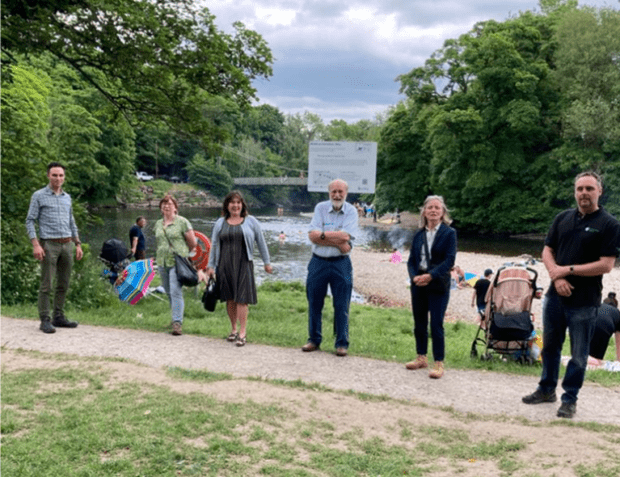
The Chair of the Environment Agency, Emma Howard Boyd, visited the River Wharfe in Ilkley, Yorkshire, last week.
While she was there she met Liz Barber, CEO of Yorkshire Water, Roger Falconer, chair of the Wharfe Partnership, and Karen Shackleton, Rick Battarbee and Kathleen Roberts from the Ilkley Clean River Campaign. The group discussed the challenges facing the local water environment including the huge issues posed by wet wipes and other forms of sewer misuse, as well as potential solutions for the area. This included a visit to Ilkley Tarn to discuss the options for holding back water from the sewer network, and the Ashlands Wastewater Treatment Works to consider the scope for increased storage.
The River Wharfe, which is a popular swimming spot for locals and tourists, recently became the first river in England to be designated as a bathing site.
That means that water quality in part of the river is now being regularly monitored by the Environment Agency to assess bacteria levels. This in turns helps assess what action is needed by water companies, land owners and others to make sure the water is clean and safe for swimmers.
While the designation of the River Wharfe is a landmark step in bringing about changes to water quality, it will require long-term collaboration, investment and innovation.
Last year Yorkshire Water announced the Wharfe Partnership, bringing together the Environment Agency, the National Trust, Yorkshire Wildlife Trust and the Yorkshire Dales Rivers Trust, alongside Bradford Council, the CLA and others to look at the impacts on water quality across the catchment, including from agriculture.
The Environment Agency continues to play an active part in the work coordinated by the Yorkshire Dales River Trust which works on projects across the wider catchment. It also recently hosted a Citizens’ Jury event to hear views from the public and environmental experts on all aspects of the water environment in the area.
The monitoring at Ilkley is being carried out at the Cromwheel sampling point between Ilkley Old Bridge and the suspension bridge, which is where most bathers are expected to use the water. The EA will also be carrying out further monitoring at a location downstream of the suspension bridge and Ashlands Wastewater Treatment Works.
Chair of the Environment Agency Emma Howard Boyd said:
I was delighted to visit the beautiful River Wharfe last week to see the vital work being done by the Environment Agency and other partners to address the challenges facing the water environment.
The River Wharfe is a frontrunner in driving the collaboration that is so important to delivering the action we all want to see in rivers across the country. This first river bathing water designation can help us understand whether the current approach to bathing water designation and management may need to evolve.
I would like to thank the community and local partners for steadfast determination on this project and reiterate the Environment Agency’s commitment to working with them and others to drive change.
Liz Barber, Yorkshire Water CEO said:
It’s clear that the public has high expectations for improvements in river water quality and we want the Wharfe to be an exemplar of how those expectations can be met.
Rivers are complex systems and it is important we understand just how they work and also what changes, whether in land use or waste water treatment, will have the biggest impact. Some of the changes will be long term and will take time, but there are other things we can do, particularly using technology to reduce discharges, which we can get started on straight away.
Partnership approaches are key. Water companies, land owners, the EA and the public need to work closely together to bring change. On the Wharfe, there is a powerful coalition committed to delivering sustainable improvement and I am sure that this will make a real difference.
Karen Shackleton, founder of the Ilkley Clean River Group, said:
We are pleased that the Environment Agency is committed to tackling the problem of sewage pollution in our local river from combined sewer overflows and proud that our campaign has resulted in the Wharfe becoming the first river to be designated as a bathing water site in the UK.
We hope that any lessons learnt from the Ilkley experience will help improve the designation process for running water bathing sites here and elsewhere in the country and we look forward to working together with the Agency and Yorkshire Water in future to ensure that solutions to sewage pollution are found and implemented as speedily as possible.
Bathing water sites in England have been monitored by the Environment Agency since the 1990s and since have seen a significant improvement in water quality. In the 1990s just 28% of bathing waters met the highest standards in force at that time. In 2019, 98.3% of bathing waters met the minimum standard, with 93.3% reaching the highest standards of Excellent or Good.
Anyone can check the quality of the water before visiting a bathing site by going to the EA’s Swimfo website.

Leave a comment